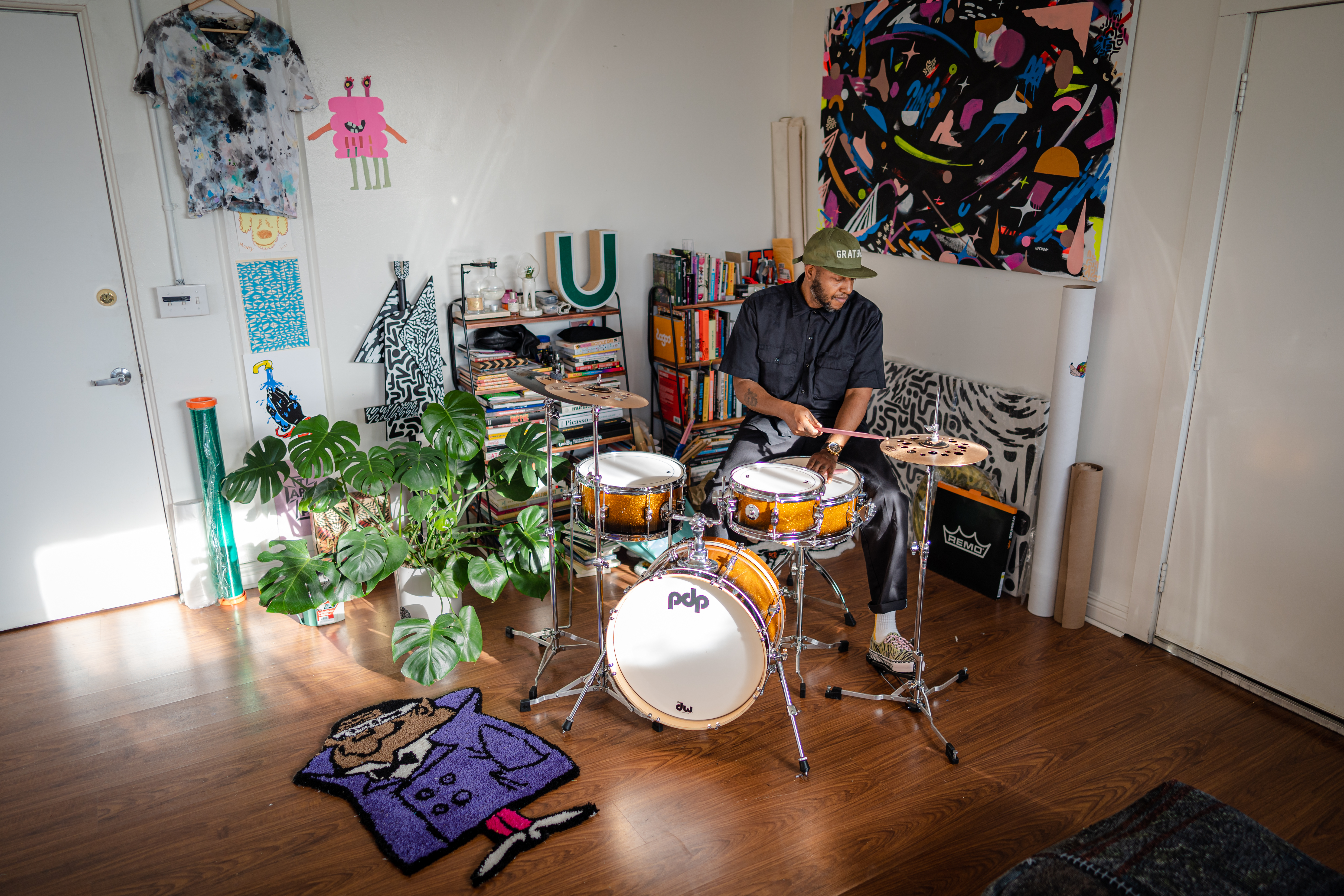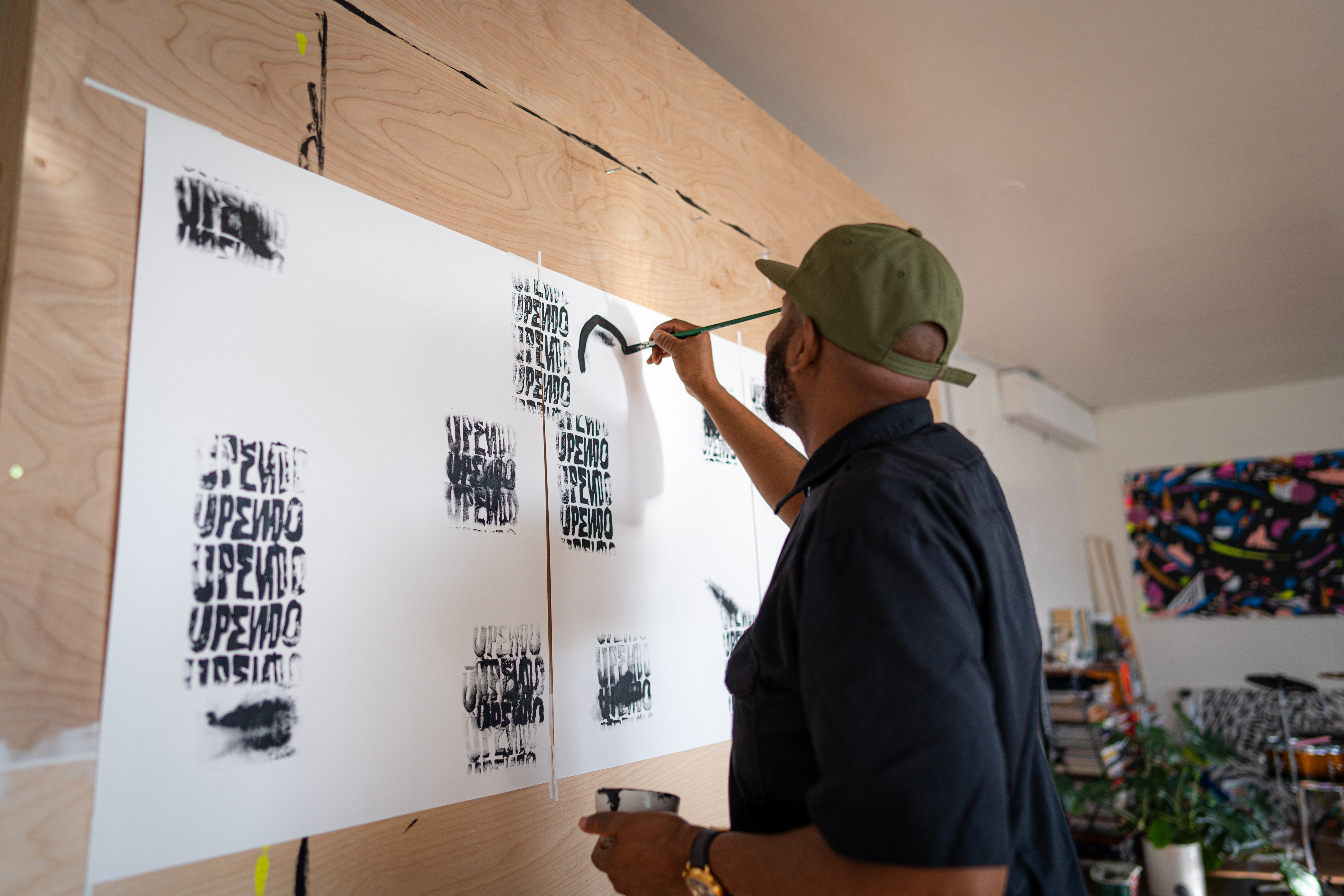For artist Upendo Taylor, sound is the catalyst to his body of work.
As he hears a beat or a piece of music, he sees shapes and patterns—a perceptual sensation known as synesthesia. What comes out of it? Evocative and abstract designs charged with the same energy and dynamism as the beats they were born from.
Upendo takes us through his unique style of “Graphic Poetry” and discusses how music and synesthesia influence his art.
Tell us a little bit about yourself and your artwork—a short elevator pitch if you will.
I’m Upendo, a biomorphic surrealist—a fancy way of saying abstract artist—and my work comes from sound and the interpretation of sound through balance and composition.
Can you describe in your own words what Graphic Poetry is?
Graphic Poetry is all of my influences coexisting in a pure state—my background as a graphic designer using bold shapes and the flow of poetry to interpret those visuals. All together, you get Graphic Poetry.
I began my career as a production artist/designer/illustrator for a skateboard company. Also, in my past I was a graffiti artist, tagging and riding in the streets. Then in 2017, I left my nine-to-five job to be a full-time artist—it was kind of nagging at me. All that to say, all of this stuff informs what I do now.

What role does sound play in your art?
Music is a big part of my life—both by listening to it and making it, but also because it heavily influences my work and creative process. I might hear something, make a beat or track, and then try to interpret that track visually by sitting with it, meditating on it, and allowing those shapes and patterns to form in my head. Then I put it down.
Sometimes the opposite happens; I’ll turn a visual into a sound instead. I might see something that I sketch and try to make a beat that sounds like it—it’s that pure first instinct type of design work.
What music are you pulling the most influence nowadays?
Hip-hop, funk, a lot of parliament funkadelic—that trippy Black rock. Heavily it drives the sound. A lot of beats, J Dilla, Madlib—those types of eclectic artists are part of my DNA.
What inspires you the most these days? It can be any artistic medium or new food inspiration!
Right now, it’s probably my music—making beats and songs. I found out my girl can play saxophone, a little piano and a little bass. So it’s like, Oh wow, we got another mix of things to do when we’re hanging out. Lately, we’ve been making random sounds by experimenting with music, and it’s cranked up the patterns and biomorphic shapes I’m seeing in my head.
What you’re describing sounds to me like “synesthesia.”
Yes. I don’t know if I have it—I don’t want to say whether or not I do—but people have mentioned it before.
I did a show two years ago in Highland Park called “Synesthesia.” People saw my work and were like, it’s cool; it’s patterns; it’s abstract. But I’m like, nah, you don’t hear a drum beat when you look at that pattern like I do. I can see the drum pattern; I can hear the waves; I can see the chords.
These shapes are hidden in the back of my mind. It was a few years ago when I really started to play around with that discovery. I was working with a music producer called Black Milk, working on an album with him called “Glitches in the Breaks,” and it was the exchange of his music that sparked particular shapes in my head. That was one of the first sets of patterns and shapes that came to me after listening to beats. Those shapes are what ultimately became the album cover.
I think that was the turning point. Other clients and companies began to reach out, and that’s when I did my collaborations with Reebok.
How do the cities you’ve lived in influence your work? In what ways has Graphic Poetry evolved as you’ve moved cities?
New York has so much day-to-day inspiration. As soon as you walk out of your crib, even in your crib, there’s inspiration. And once you start drawing from those influences, it definitely changes your artwork.
New York was built for me—that kind of hustle mentality was already in me, so when I got to New York, I was like Oh yeah, this is it. At the time, there was a heavy youth culture, so you know New York was run by the kids then. You could feel that energy. Once I got there, it just kind of opened my head up to the possibilities. New York is a hard city; if you can make it there, you can make it anywhere.
What are your favorite spots in New York to spend time in or gather inspiration?
When I was living there, I hung out a lot in the Lower East Side. There was a lot of great street art happening south of Houston Street. Also, Brooklyn, seeing the evolution of that area. And Williamsburg at the time was pretty crazy.

You’ve created art for different mediums: murals, fine art, apparel, textiles, digital. Do you have a favorite medium to create for?
They’re all my favorites. So many things have changed since I was first learning about art. You see the greats and how they were able to evolve and be versatile. That was something that originally stuck to me in my creative process: wanting to be able to create whatever I wanted with whatever I wanted. That’s what art is about for me. That’s that full expression.
You know, I have peers and other artists who find their little tricks, the thing they do that cracks the code, and then they just stick to that. And I’ve found out from conversations that a lot of them aren’t really happy because they’ve had to stick to that style or had to turn themselves into a brand, and I never really want that for myself because then you’re locked in to what your audience has defined for you. For me, to be able to pivot, bounce and switch it up is fun. That’s what keeps me energized. That’s what keeps me wanting to do this.
You’ve created incredible art and exhibited throughout your career. You’ve also worked with a plethora of clients from record labels like Columbia, to lifestyle brands like Nike and Adidas, to fashion brands like Guess. You’ve helped create an apparel brand called Leroy Jenkins with your partner Ron Upperman. Among all those projects and collaborations, what’s been the most gratifying for you so far in your career?
Overall, all of them are great and gratifying because I’m being approached by companies for me. There’s nothing to hide. I never could have told you 10 or 20 years ago that this would be my moneymaker, that this would be the thing that gives me work. It’s a great feeling just to be able to fully express yourself and then be embraced by a company for it—it’s wonderful.
What was it like seeing Jay-Z wear a Leroy Jenkins cap?
That was one of the coolest things to ever happen—it was the shit. It’s a crazy story. One of these guys that has worked with Jay-Z’s brand was like “Yo, I could get him these hats.” I hung out and waited around to hear back but had to leave for a flight to LA. When I landed, I opened my phone up, and everybody was like, “Yo!” I’d missed it because of the five hour flight, but Jay-Z wore it at his South by Southwest show. I was like “Holy shit. That’s fucking cool.” He loved it. He was spotted rocking them for a while. That was a proud moment for sure.
Do you have advice for other artists who want to find collabs and brands to work with?
Keep working. I’m not intentionally doing it. I’m not chasing brands down. They’re gravitating to me. And those are the companies I would prefer to work with because they’re getting about who I am.
What’s next for you in 2022?
I’m having a solo exhibition running from February 5th to March 6th with The Line Hotel in Koreatown. It’s basically an installation in the lobby, and I’m making four new giant pieces there. This show is tentatively titled “Experiments in Sonics,” and basically, it’s my most recent expression from the music I’ve been creating with my girlfriend—that vibe, that feeling, how it’s flowing with us right now and myself.
I just completed a city project redesign of Leimert Park. So I’ll be painting the crosswalk on 42nd and Degman and the Vision Theater Plaza in Leimert Park. And I redesigned all the signage, font treatments, created a color palette and kind of a motif for Leimert Park that is going into construction in February. That’s supposed to be done by the end of march. And then, I have a project with Pepsi coming in February as well.
Photography by Jonathan Jovel
Shop Upendo’s work below and check out his Society6 shop for more.
Comments